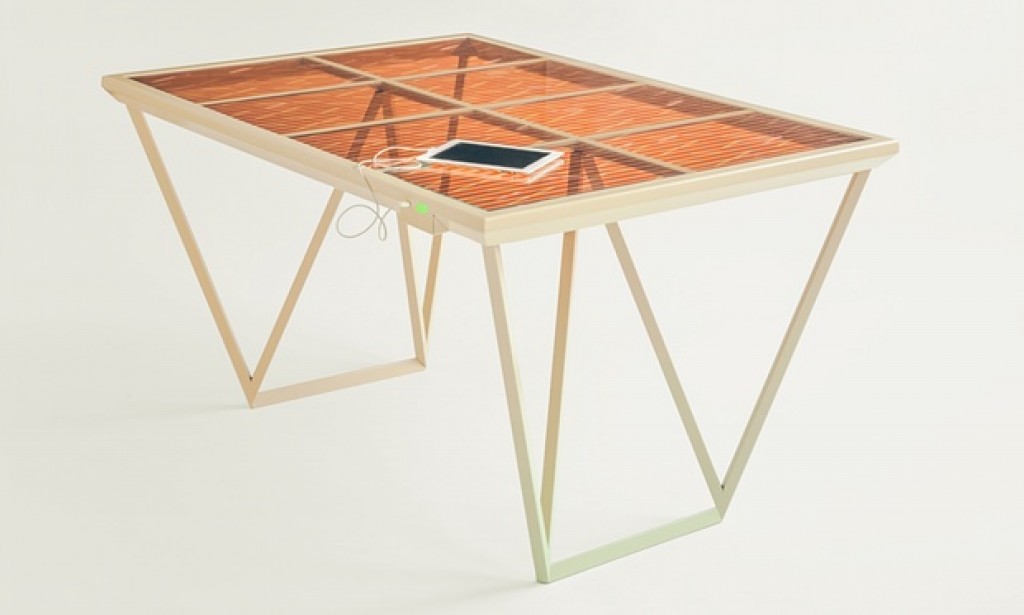RECOMMENDED VIDEOS

Eco-Friendly Cleaning Products Sydney | Liquid Magics Australia
Liquids Magics Australia

Smead 100% Recycled Products Video
The Smead Manufacturing Company Inc

What is Tower Garden® Vertical Aeroponic Growing System?
Tower Garden

Eco-friendly Products for a Green and Safe Nursery
Stacey Jane's Nappy Cakes

Cleaning Block Paving Driveways,Sealing with Eco-Friendly…
Smartseal UK Ltd
Related Stories
RepAir T-shirt cleans the air while you wear it
German city offers ingenious alternative to single-use coffee cups
These vegan “Star Wars” sneakers are made with discarded pineapple leaves
Loch sunglasses are made of 500-year-old timbers from the Great Lakes
Freitag Bags still going strong after 24 years
15 Dec, 2015

Solar Table Charges Your Phone Without Direct Sunlight
Eco Products & Services | UNITED KINGDOM | 15 Dec, 2015
Published by : Ecotechtube
The kitchen table has been the place where many new inventions and ideas have been sketched out, but rarely has it been the source of innovation itself.
With an orange-striped surface on its steel frame, a new table from London-based designers Caventou appears to be an ultra-modern piece of furniture for an arty homeowner. A closer look reveals a port on the side where phones can be recharged using power gleaned from solar cells that cover the surface.
The table is expected to go into production next year, using solar cells that do not need direct access to sunlight.
These dye-sensitised solar cells mean that household objects, such as phones, lamps or laptops, can harvest energy from indirect sunlight and then store it later, instead of having to plug the appliances into the wall.
It is, according to creator Marjan van Aubel, an altogether more subtle use of solar cells than planting panels on the roof. “[I] want to design cells that can be fully integrated into your daily life, that you are not aware [of] ... ,” she said.
The solar cells used in the Caventou Current Tableemerged almost 25 years ago, using a process similar to photosynthesis in plants. A dye in the cells – orange in the table – can produce energy once it is sensitised to light. A USB plug in the side means that phones can be recharged and a light plugged in, so that the table remains independent of any power source apart from itself. A network of cables runs around the perimeter of the table and the energy is stored in a battery for use at a later stage.
“I found out that colour is able to generate electricity,” van Aubel said. “Colour is not only for aesthetics but has an extra function.”
Peter Krige, the head of technology at Caventou, said that in terms of solar cell development, the dye-sensitised cells they are using are relatively new.
For best results, the table needs to be positioned in a room with a good source of light, such as a conservatory, sunroom or kitchen. “You’ll collect the most power from the sun on bright, clear days. That being said, dye-sensitised solar panels are less affected by diffuse light levels and shadow from clouds. Although the efficiency of the solar panel will decrease in cloudy conditions, you’ll still be collecting valuable power from the sun,” van Aubel said.Where there is less light, such as in Nordic countries at certain times of the year, there will be less energy generated, said Krige.
The first version of the Current Table has been completed and is on display in the Design Museum in London. And the next generation of the table, which is expected to start production in the new year, will be able to power both phones and laptops. “On an average day in London indoors it can power three phones and a iPad or one computer and a phone ,” van Aubel said.
The company has also developed “Current Windows”, a combination of stained glass and solar cells that have USB ports in the ledges for charging devices. A series of them were put in place in a Soho gallery for 10 days so that people on the street could power up their phones.
Behind both inventions is a quest for efficiency by van Aubel. An earlier project involved a cabinet that also used the cells within glass panels. She said this results in objects having two functions: the one they are traditionally used for and another to gather energy. With the advancement in solar technology, an increasing number of objects will be able to be used to store energy, she said.
The early use of the technology comes at a price. It is expected that the first consumer editions of the table will cost between £2,000 and £3,000. Three orders have so far been placed, said van Aubel, from buyers said to have both environmental and design interests. Future versions could involve induction charging, where items just have to be placed on the surface.
Getting colour from light
The company Caventou was named after the French chemist Joseph-Bienaime Caventou. Along with his colleague, Pierre Joseph Pelletier, he isolated and named chlorophyll, the green pigment involved in photosynthesis (the process by which green plants convert the energy of sunlight into chemical energy). In a similar way, the dye-sensitised solar cells used by the company Caventou convert sunlight into energy. The dye is the photoactive material of the cell, which means that it is capable of a chemical or physical change in response to illumination, and can produce electricity when sensitised by light.
Original Article From :The Guardian
By :Shane Hickey
